Did you know that the power of a single social media post can significantly influence brand loyalty?
According to Reputation Refinery, people who share negative mentions of a brand are half as likely to follow a brand than those who share positive mentions. This is why social listening is such a powerful, yet underrated marketing instrument.
In this article, I am addressing every aspect of social listening including what types of social listening are there and how they can be leveraged, what is AI social listening, social listening strategies, the difference between social media listening and social media monitoring, what metrics are important, and what free tools can you use for an organic social media success.
Social listening - the secret path to organic social media success
1. What is social listening
It looks to encompass understanding the sentiments, trends, and insights expressed by consumers across various social media platforms.
This process enables marketers to better understand their audience's perceptions, needs, and expectations, facilitating more informed decision-making and strategic planning.
However, to better when and how to practice social media listening, we need to understand its functions by looking closely at the types of social listening.
According to a 2022 Social Media Today report, almost 61% out of 650 respondents declared they had a social listening system in place, and more than 82% viewed it as a key planning element.
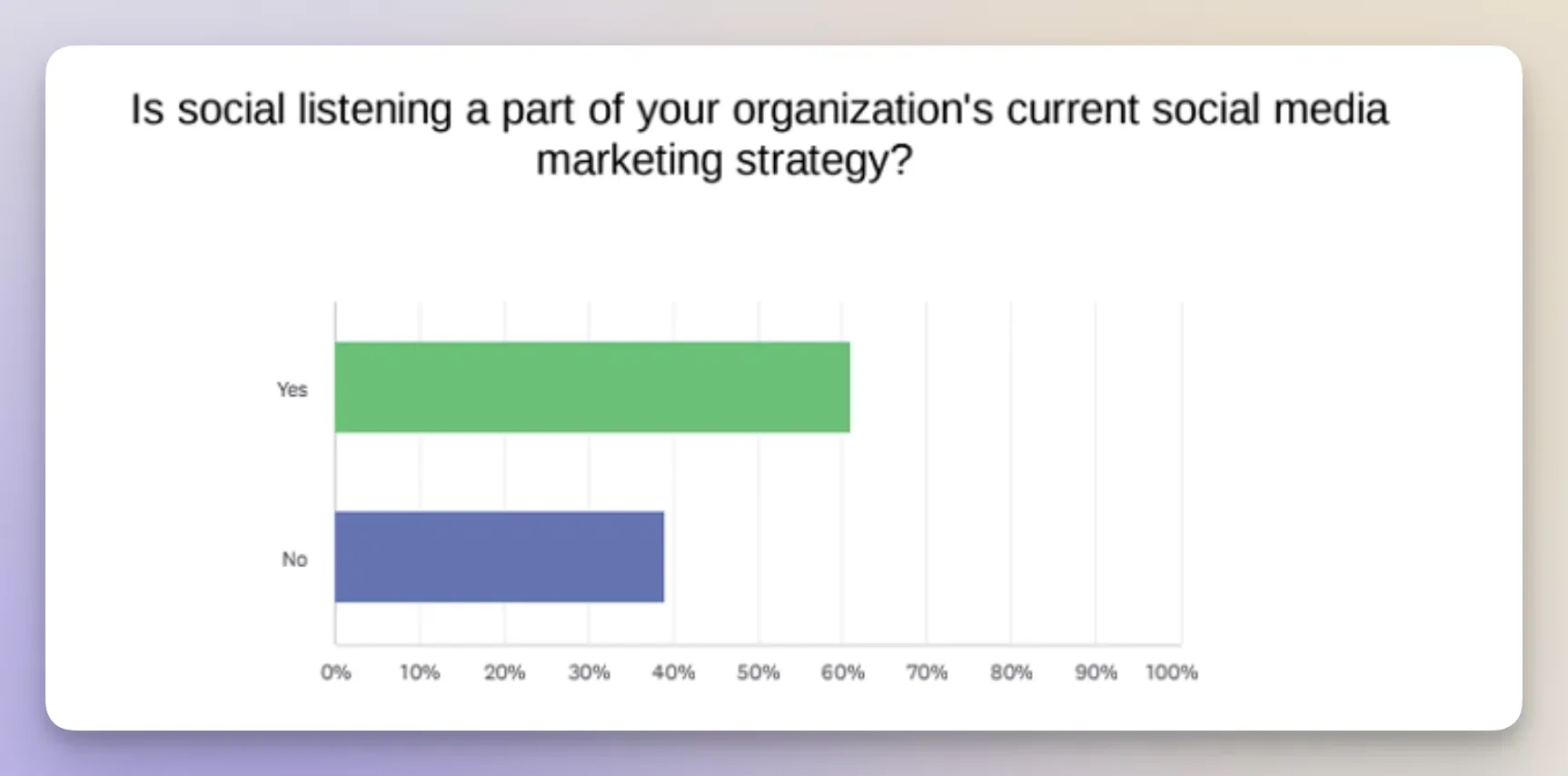
2. Types of social listening
There are several types of social listening, each serving different strategic purposes:
- Brand mentions listening
- Competitor monitoring
- Industry trends listening
- Campaign analysis
- Customer service and support
- Influencer collaboration
- Product feedback and innovation
#1. Brand mentions listening
Brand mentions listening involves tracking mentions of your brand across various platforms.
It's not limited to social media and can also include forums, blog articles, news sites, and any digital space where your brand might be mentioned.
Brand mentions are an essential part of brand monitoring and it helps with tracking the public perception of your brand and addressing feedback or criticism promptly.
#2. Competitor monitoring
By listening to conversations about your competitors, you can gain valuable insights into their strategies, strengths, weaknesses, and customer feedback.
This information can help you identify opportunities for differentiation and areas for improvement in your offerings.
#3. Industry trends listening
Industry trends listening involves looking at discussions related to your industry at large.
It helps in staying up-to-date with emerging trends, technologies, and shifts in consumer behavior. By understanding these trends, businesses can make more informed decisions and adapt their strategies accordingly.
For example, here’s how the engagement on #taylorswift skyrocketed since the 66th edition of the Grammys when she announced her new album “The Tortured Poets Department”.
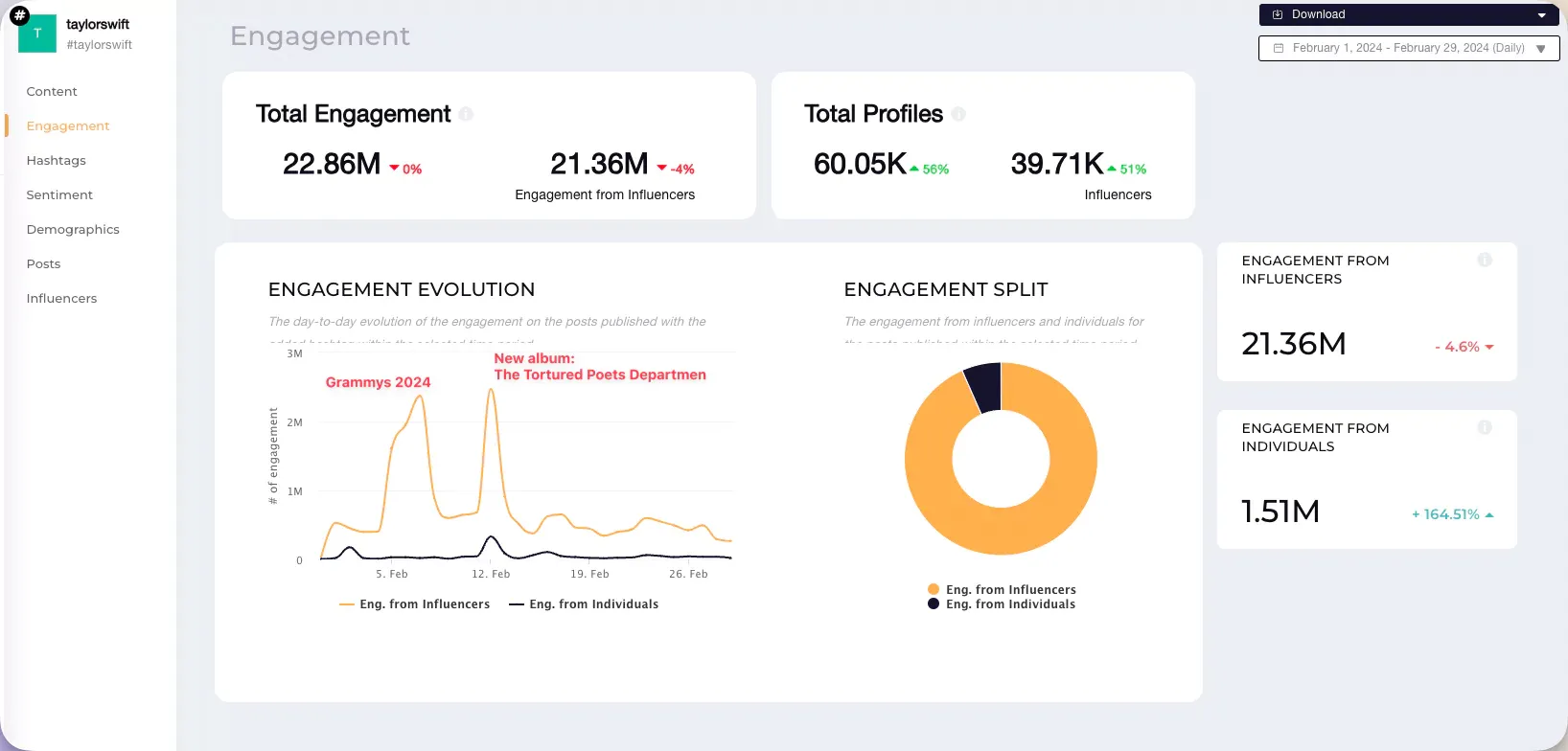
#4. Campaign analysis
When running marketing campaigns, social listening is a crucial element in tracking the campaign's performance in real-time. This includes measuring engagement, sentiment, and overall reception of the campaign.
Insights gained from this type of listening can be used to make adjustments to the campaign strategy, for example, to prioritize channels based on results.
Taking the same example, looking at the sentiment around the formerly mentioned event, it seems that Taylor’s reputation (pun intended) continued to take a positive turn.
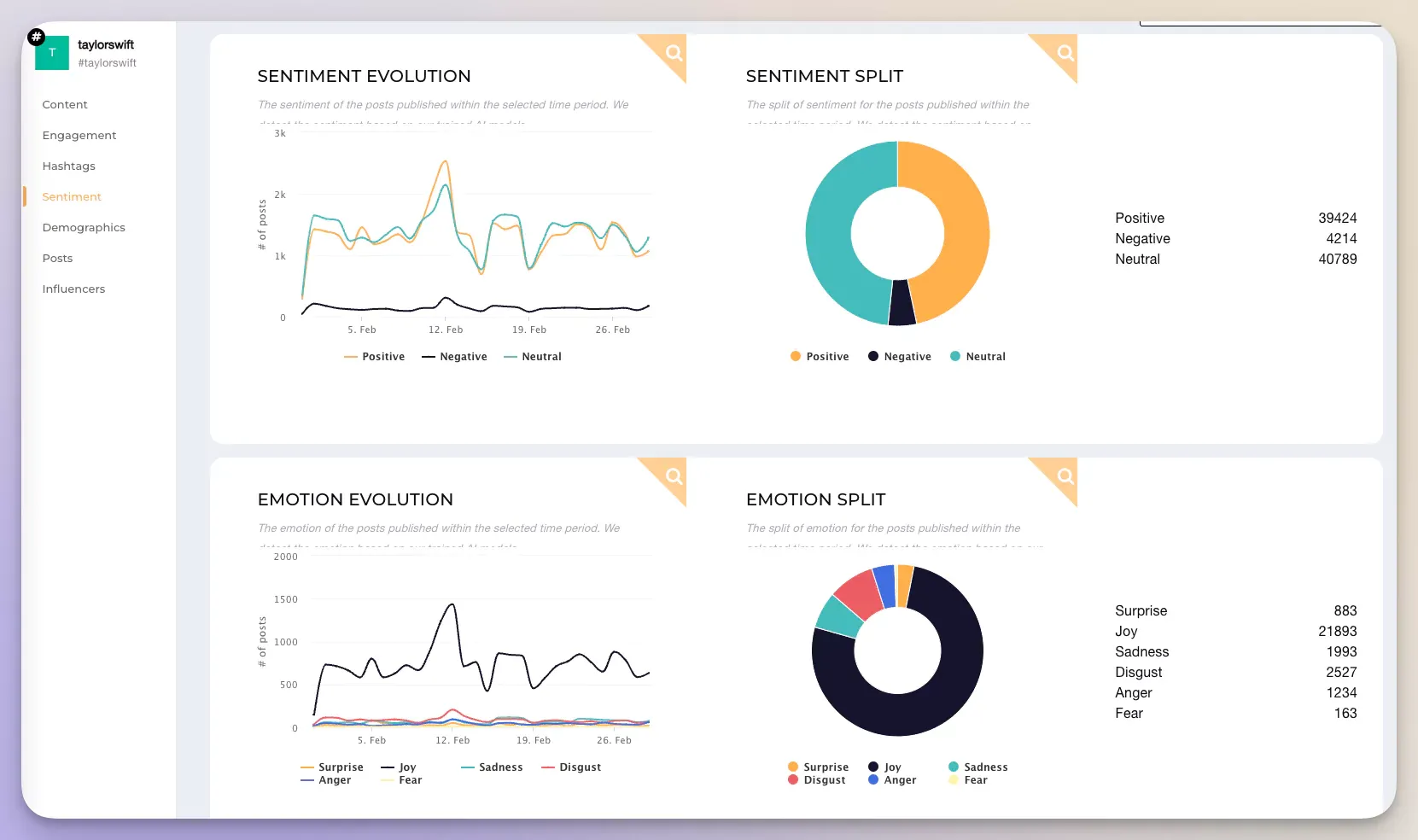
#5. Customer service and support
Social listening can be a powerful tool for identifying and resolving customer complaints or queries online. By actively listening for mentions of your brand in the context of customer service issues, you can address problems promptly and improve customer satisfaction.
#6. Influencer collaboration
Identifying and collaborating with relevant influencers in your industry can be facilitated through social listening.
Using AI-Instagram listening tools, you can easily target who the key influencers are and what conversations they're endorsing, you can choose which content creators are best suited to amplify your brand's message.
#7. Product feedback and innovation
Listening to customer feedback on your products or services can provide valuable insights for improvement and innovation. This type of listening can reveal what customers like, dislike, or wish to see in future offerings, guiding product development and innovation strategies.
Each type of social listening offers unique benefits and can be utilized in various combinations depending on an organization's goals and the specific dynamics of its industry.
Effective social listening requires the right tools and a strategic approach to interpret social listening metrics and translate them into actionable insights.
Here’s where the power of AI comes in👇
3. The definition of AI social listening
Unlike traditional social listening, which primarily relies on keyword tracking and surface-level data aggregation, AI social listening delves deeper into the pool of nuanced human communication.
By using sophisticated algorithms, natural language processing (NLP), and machine learning techniques it can decode the subtleties of sentiment, context, and emotional undertones, in real-time.
Here’s an example of how AI can detect and create sentiment analysis on the #Grammys.
We can clearly see that the majority of posts related to this hashtag have a positive feel, while the dominant emotion is joy.
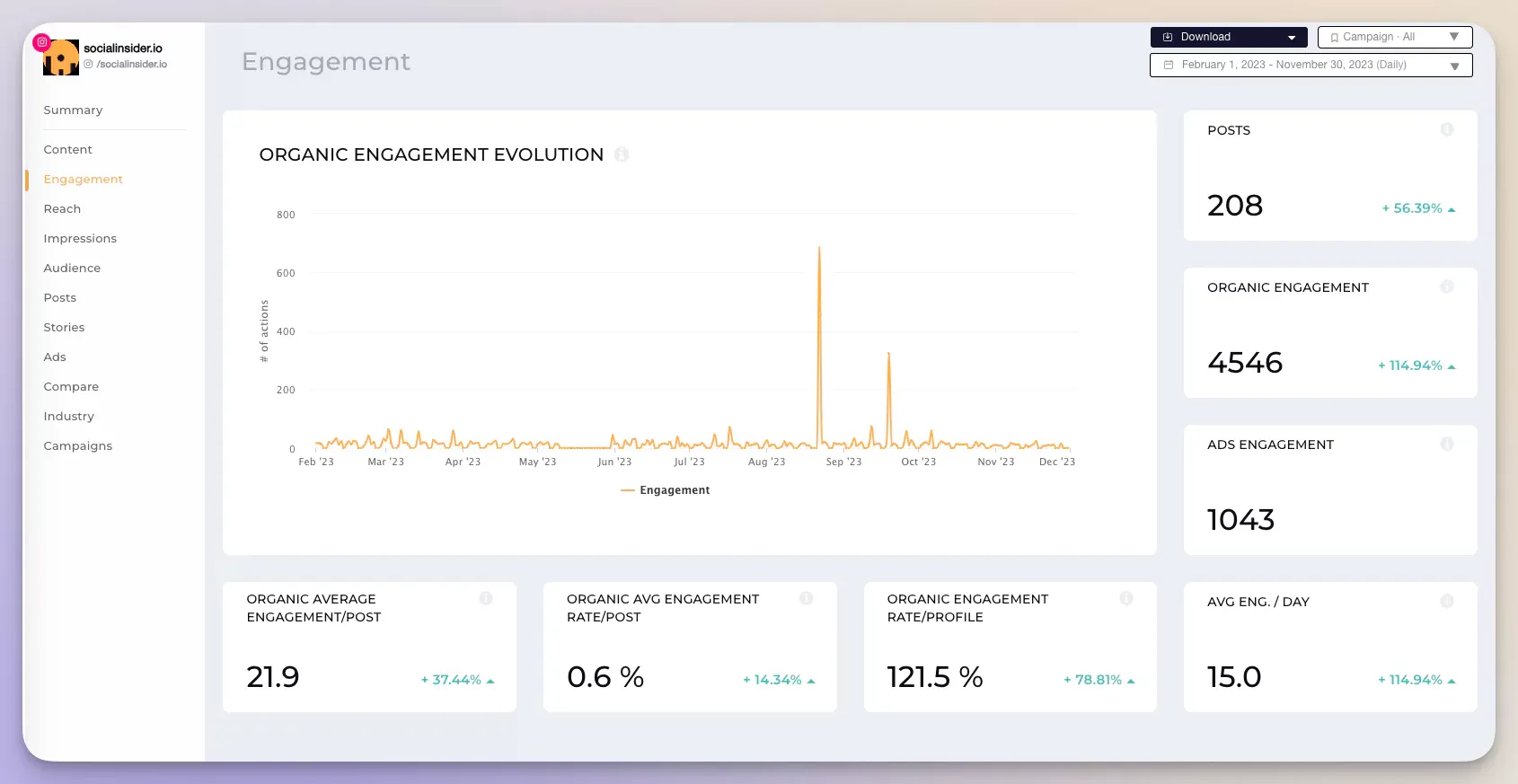
AI social listening can be considered an advanced form of the various types of social listening mentioned earlier, acting as a digital ear to the ground, transforming raw data into actionable intelligence.
Of course, to get the best results, the social media marketing team is an undeniable, essential player needed to interpret the social listening data and create bespoke future strategies.
4. Why is social listening important
For social media strategists and marketing managers, social listening is a vital tool in crafting and refining marketing strategies. It helps them identify what’s working and what’s not working, discover emerging trends, understand competitor performance, and uncover gaps in the market.
So let’s break down some of the key social listening benefits:
1. Adapting the content and communication strategy to the target audience
2. Understanding different social media platforms' potential
3. Influencer identification and collaboration
4. Crisis management and mitigation
5. Data-driven decision-making and competitive advantage
6. AI-enhanced insights and predictions
1. Adapting the content and communication strategy to the target audience
Social media listening enables marketers to tune into the online conversation of their consumers.
By understanding what the audience is saying, marketers can adapt their content, messaging, and campaigns to better align with the preferences and interests of their target audience. This alignment enhances customer engagement, which can lead to increased brand loyalty and growth.
2. Understanding different social media platforms' potential
Depending on the business sector, certain audiences can vary in their responsiveness and level of engagement on social media.
To understand every social platform’s potential benefits for your brand, social listening tools help you benchmark social media engagement rates across all the important channels.
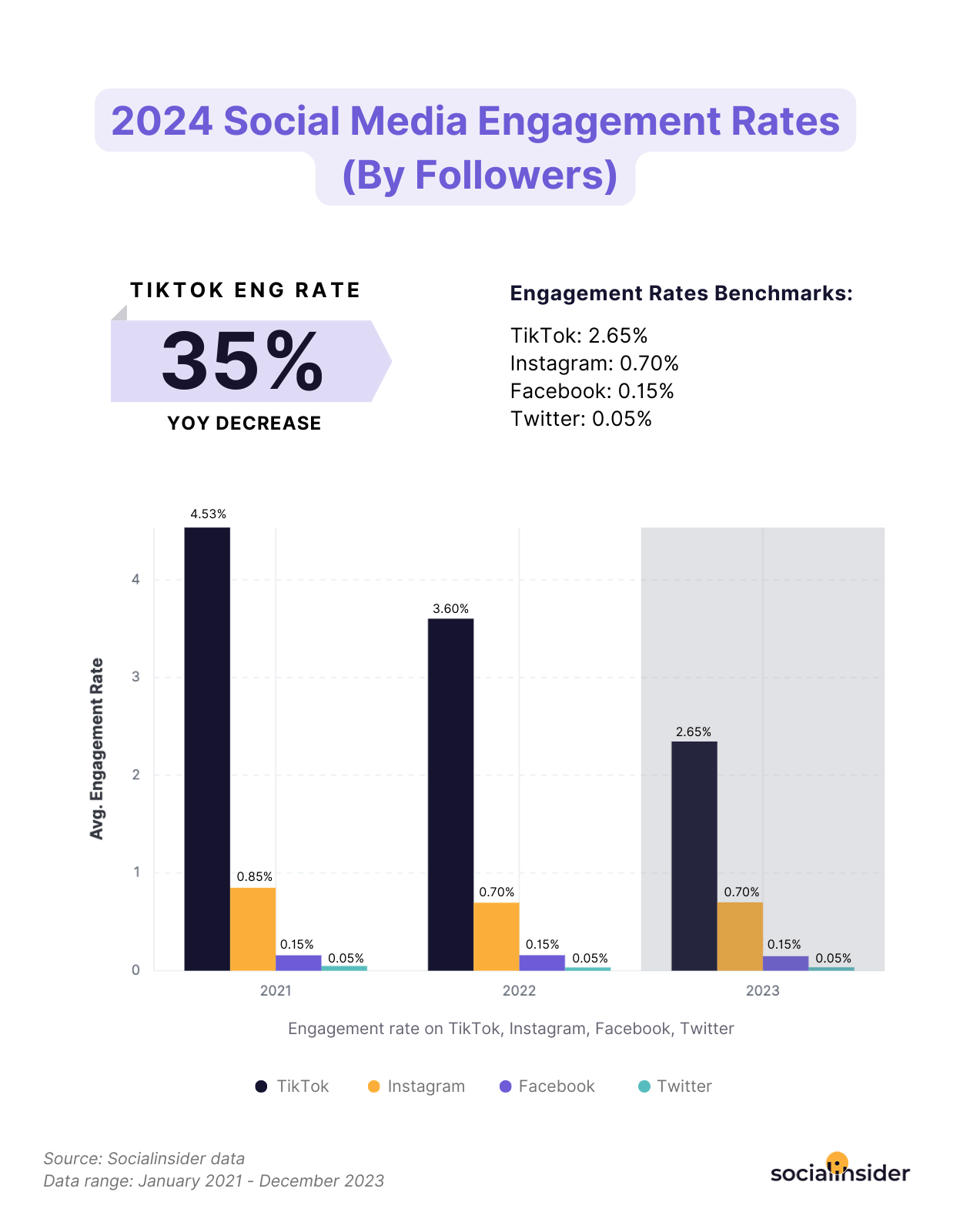
This is an example of engagement rate benchmarks across the most popular social media platforms.
3. Influencer identification and collaboration
Using the right social listening tools, brands can identify key influencers and possible collaborators within their industry or niche.
Influencer identification helps with leveraging the influencers' reach to amplify brand messages, thereby enhancing the brand's visibility and credibility amongst a wider audience.
4. Crisis management and mitigation
One of the most underrated benefits of social media listening is online reputation management.
Social listening acts as an early warning system for brands, enabling them to quickly identify and address negative sentiments or potential issues before they escalate. This proactive approach to crisis management helps maintain a positive brand image and prevents potential damage to an organization’s reputation.
5. Data-driven decision-making and competitive advantage
Social listening equips marketing professionals with the insights needed to make informed, data-driven decisions. Some tools offer in-depth competitive intelligence data which helps create more relevant, responsive, and innovative strategies.
6. AI-enhanced insights and predictions
AI social listening offers more than its traditional predecessors by processing data at a bigger scale and speed. This means more nuanced insights and more accurate predictions.
AI facilitates curated content and personalized engagement strategies, allowing for more effective interactions with customers.
For example, we found that in the beauty industry, the universal sentiment is neutral and the prevailing emotion is joy. This helps marketers create social media content centered around this powerful emotion.
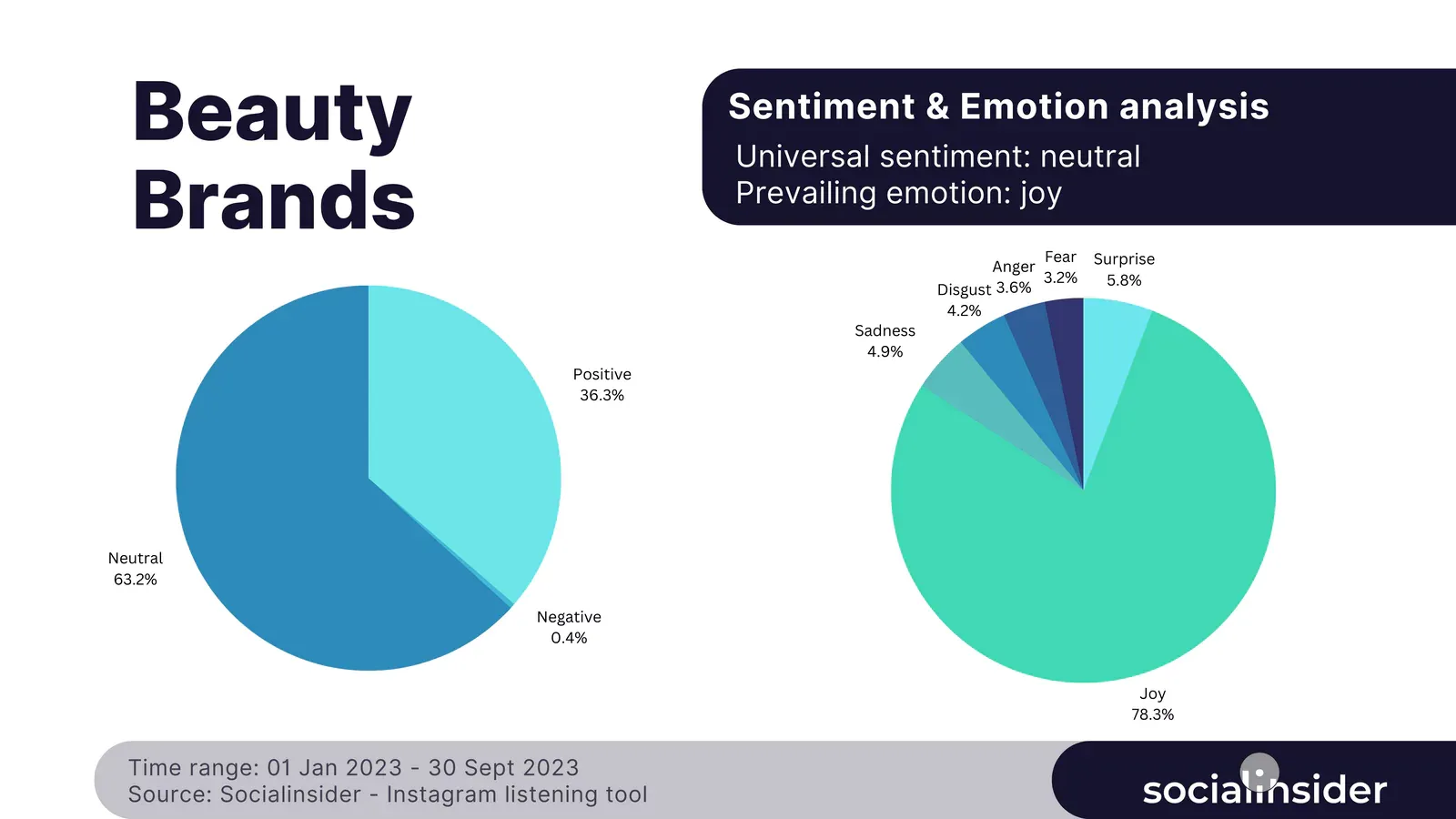
Each of these points demonstrates how social media listening, especially when enhanced by AI, provides companies and their marketing teams with a comprehensive toolkit for enhancing their strategy efforts, improving customer relationships, and securing a competitive edge in their digital niche.
Now that we understand why social listening is so important to any marketing plan, let’s take a look at what social listening strategies can get you playing in the big leagues.
Social monitoring vs. social listening
Every time you find a comment or review about your brand, products or services, your duty is to respond to them.
Quickly and in a professional, but in a friendly way, if possible. The tone is very important in these situations.
What’s the difference between social listening and social monitoring?
Social listening and social monitoring are two related but distinct practices in the realm of social media management and analysis.
Social monitoring:
- Social monitoring involves actively tracking and observing what is being said about a brand, product, or industry on social media platforms. This process typically involves monitoring specific keywords, hashtags, mentions, or conversations related to the brand or industry.
- The primary focus of social monitoring is to gather data and insights about ongoing conversations and activities on social media platforms. It helps businesses to stay informed about customer opinions, emerging trends, and potential issues or crises.
- Social monitoring often involves tools and software that collect and analyze social media data in real-time, providing metrics such as engagement rates, sentiment analysis, and trends.
Social listening:
- Social listening goes beyond simply tracking mentions or keywords and involves analyzing the broader context and sentiment behind social media conversations.
- It's important to not only understand what is being said, but also why and how it impacts the brand or industry.
- Social listening aims to uncover deeper insights into customer preferences, pain points, and overall sentiment towards a brand or product.
- It involves analyzing patterns, trends, and themes within social media conversations to identify opportunities for brand improvement, content creation, or customer engagement strategies.
Here is a comparison of social listening and social monitoring, and how these strategies can be applied.
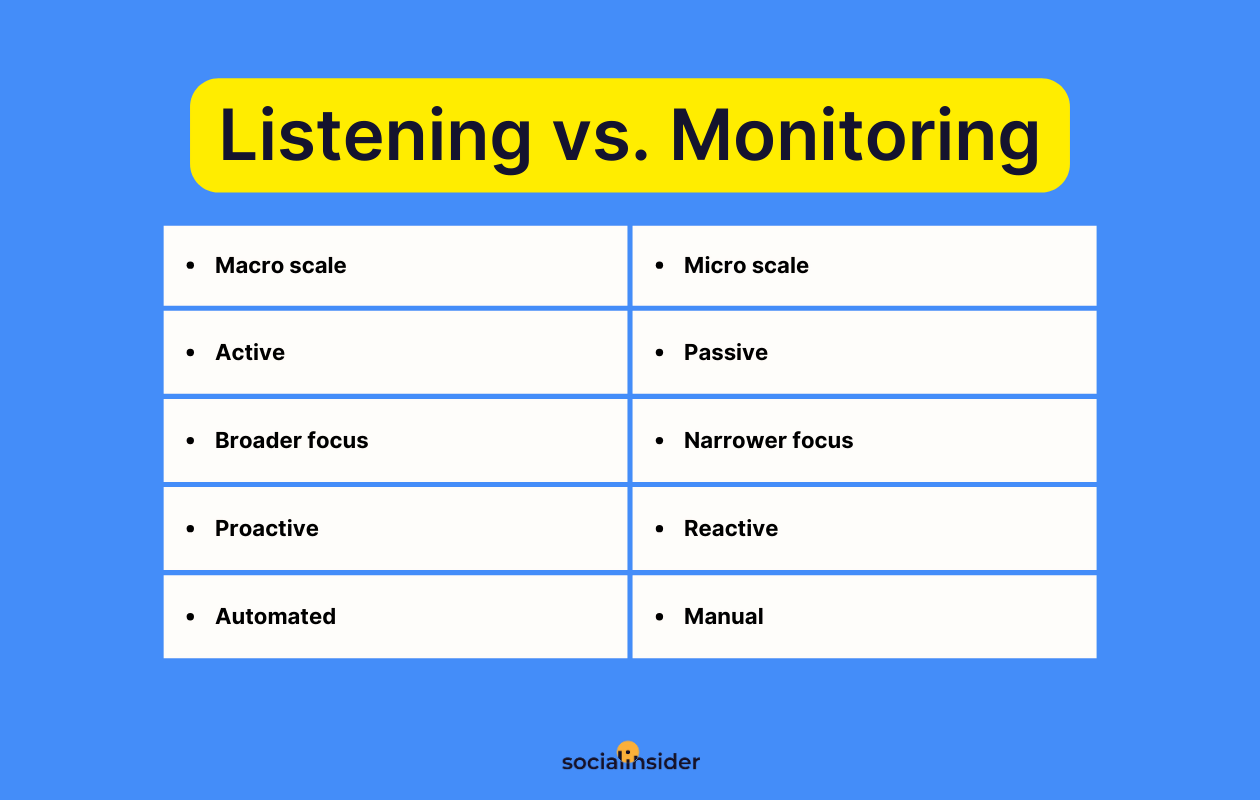
5. 10 social listening strategies
As with everything in life, getting started with social media listening involves planning the steps to get there.
From establishing your goals to setting up the processes and tools to overseeing and analyzing the social media listening metrics.
Here’s a step-by-step guide on how to do social media listening like a pro:
1. Define your objectives
2. Choose your keywords and topics
3. Select the right tools
4. Collect and analyze data
5. Engage and respond
6. Collaborate with influencers
7. Mitigate crises before they escalate
8. Monitor your competition alongside your own brand
9. Engage with people that don't mention your brand directly
10. Report and adjust
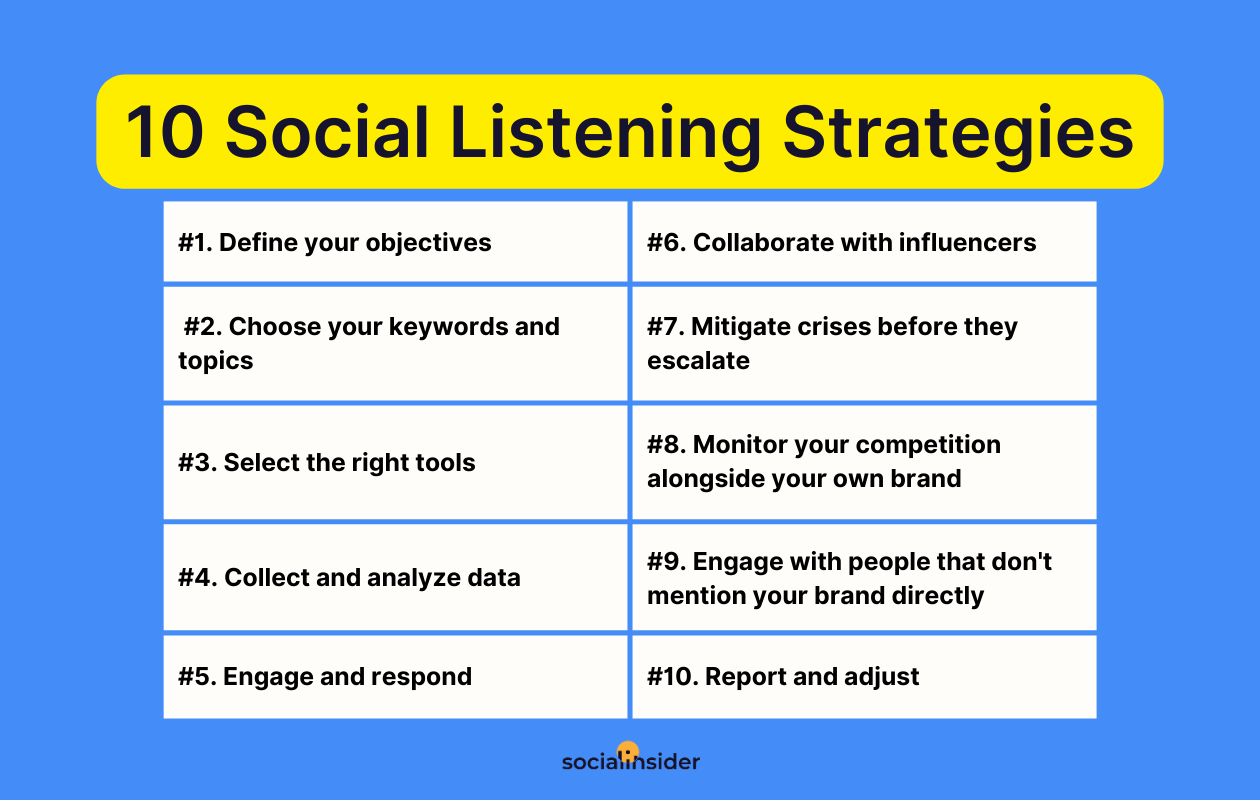
1. Define your objectives
What are you trying to achieve?
Determine what are your goals and objectives or what challenges you need to overcome. This could be understanding your audience better, improving customer service, tracking competitors, identifying influencers and industry trends, or tracking campaign metrics.
2. Choose your keywords and topics
Create a list of relevant keywords. Include your brand name, products, industry-specific terms, competitors' brand names, and any relevant hashtags.
Beyond specific keywords, think about broader topics of interest to your audience or industry.
3. Select the right tools
There are many social media listening tools available, ranging from free options like Google Alerts or Answer the Public to comprehensive platforms such as Socialinsider, Sprout Social or Brand24.
Choose one that fits your budget and delivers the social media listening metrics you need.
4. Collect and analyze data
Make social listening part of your daily routine. Set specific times to check your alerts and gather data.
When analyzing, try to look for patterns. Identify common themes, sentiments (positive, negative, neutral), and any sudden changes in volume or sentiment regarding your brand or industry.
Don’t forget to benchmark and measure.
Compare your findings against previous periods to track progress and benchmark against other relevant social listening insights.
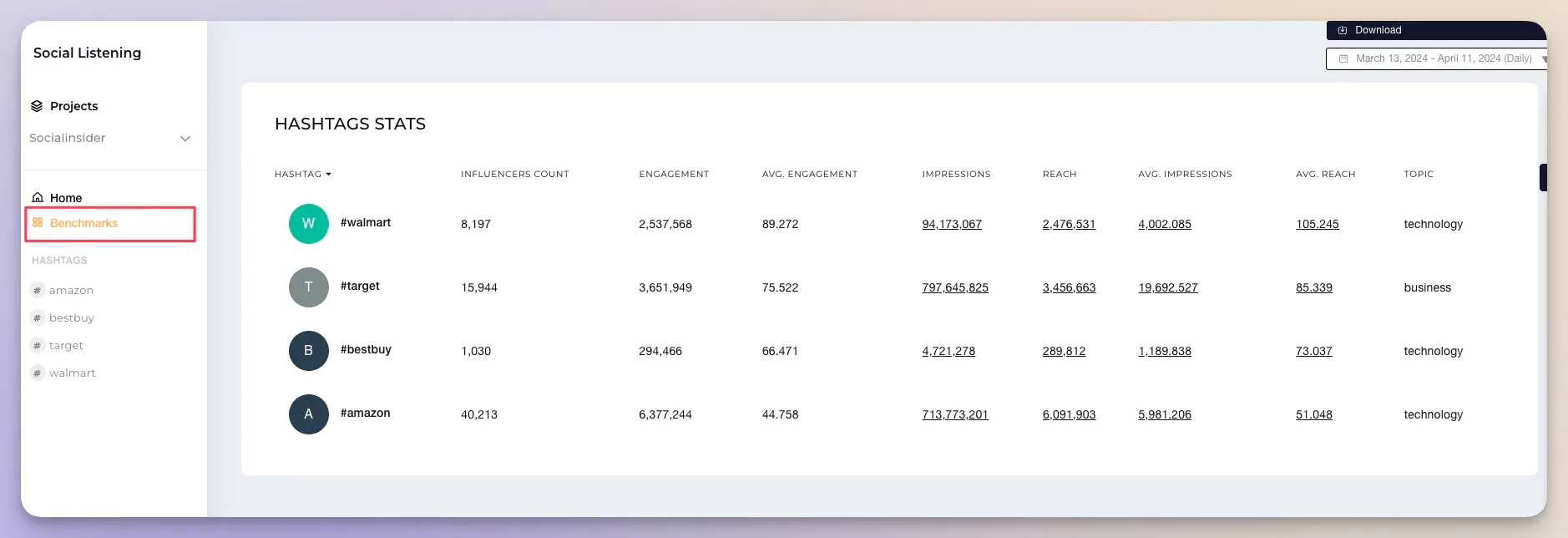
5. Engage and respond
Use the social listening analysis results to gain more knowledge on where you need to direct your customer-engaging efforts.
Join in on conversations, answer questions, or address complaints or concerns. This will help improve your brand's image and customer satisfaction.
6. Collaborate with influencers
If you are using a tool that can identify industry influencers, contact potential influencers and brand advocates to collaborate with. From micro-influencers to key opinion leaders, find the right partners to drive brand awareness and customer engagement.
7. Mitigate crises before they escalate
The internet is large and small crises might break out when you least expect it. Use social listening to monitor your brand reputation, and put out fires before they grow too big and affect your brand’s image.
8. Monitor your competition alongside your own brand
As part of your social listening strategy, you should focus on your brand’s image, but you should not disregard your competition.
While you cannot get the same listening insights for other brands as you do for your own business, it’s still worth monitoring their performance and overall reputation and use it as a benchmark.
9. Engage with people that don't mention your brand directly
The best part about social listening is that there are many ways of finding out how people feel about your brand, even if they don’t mention it directly in their posts, comments or reviews.
10. Report and adjust
Create a recurrent social media listening strategy that not only allows you to create regular reports that inform the company’s stakeholders about the brand’s positioning, but also sets the tone for planning your next marketing campaigns, and even future business decisions.
Here’s an example of how social listening can help you identify your online demographics.
Clearly, the French cookware manufacturer Tefal has a significantly bigger Arabic audience than the home-based one.
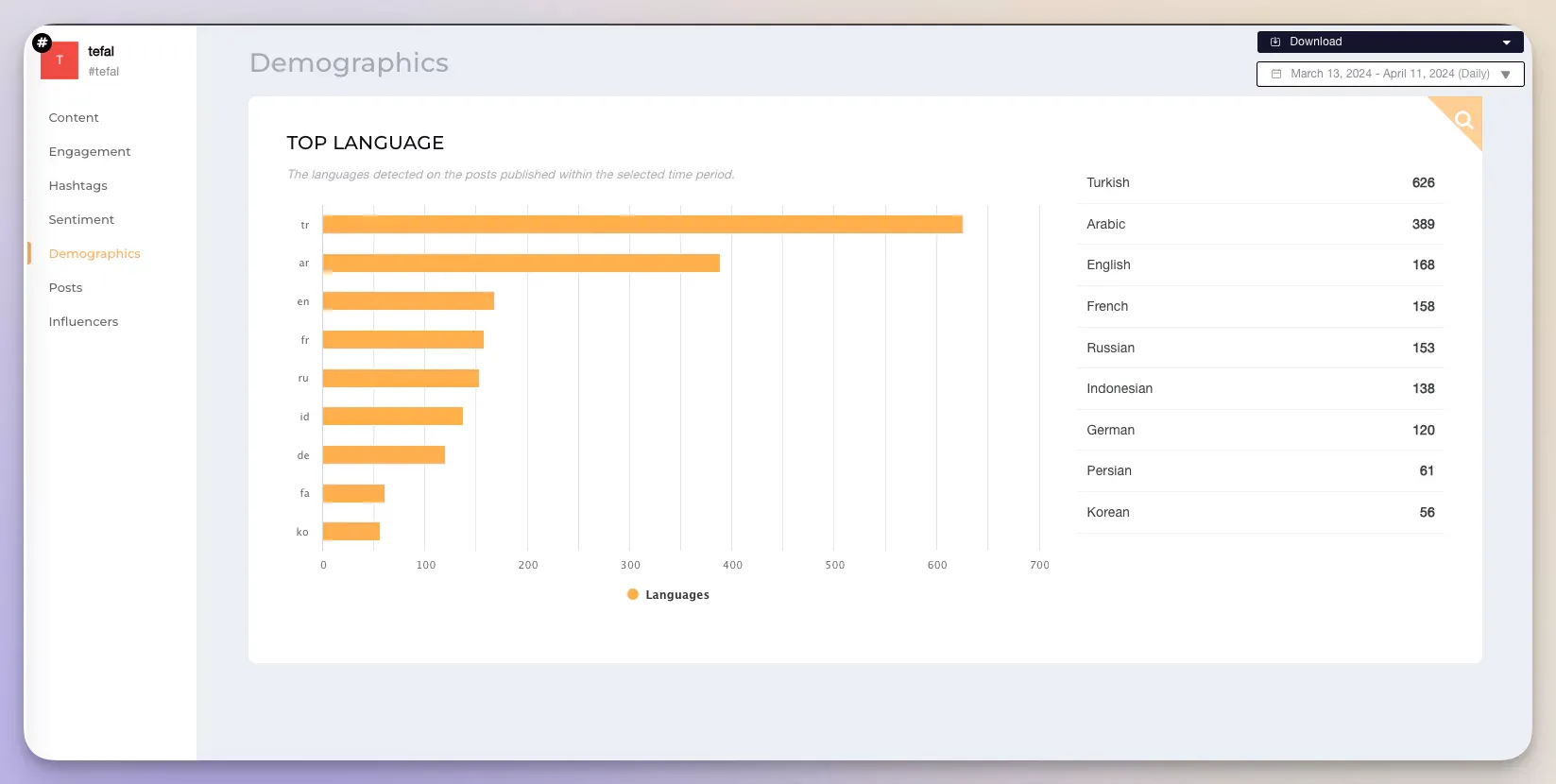
Getting started with social media listening is an ongoing process of refinement and learning.
It’s important to stay flexible and adapt your approach as you learn more about your audience, industry, and competitors, and how to interpret and translate your metrics into actionable insights.
This brings us to our next order of business - what metrics do we track and why?
6. Social listening metrics
To effectively measure the impact of their campaigns, every marketer relies on specific listening social media metrics.
It’s important to mention that the metrics used in social listening can slightly differ from the traditional social media KPIs.
Here are the most relevant social listening metrics, based on their relative importance or value:
- Mentions
- Hashtags volume
- Engagement
- Share of voice
- Demographics data
- Brand exposure through influencer marketing
- Sentiment
Tracking social listening metrics regularly can be the secret path to brand success as it helps marketers make sense of what is going on and catch waves that others miss.
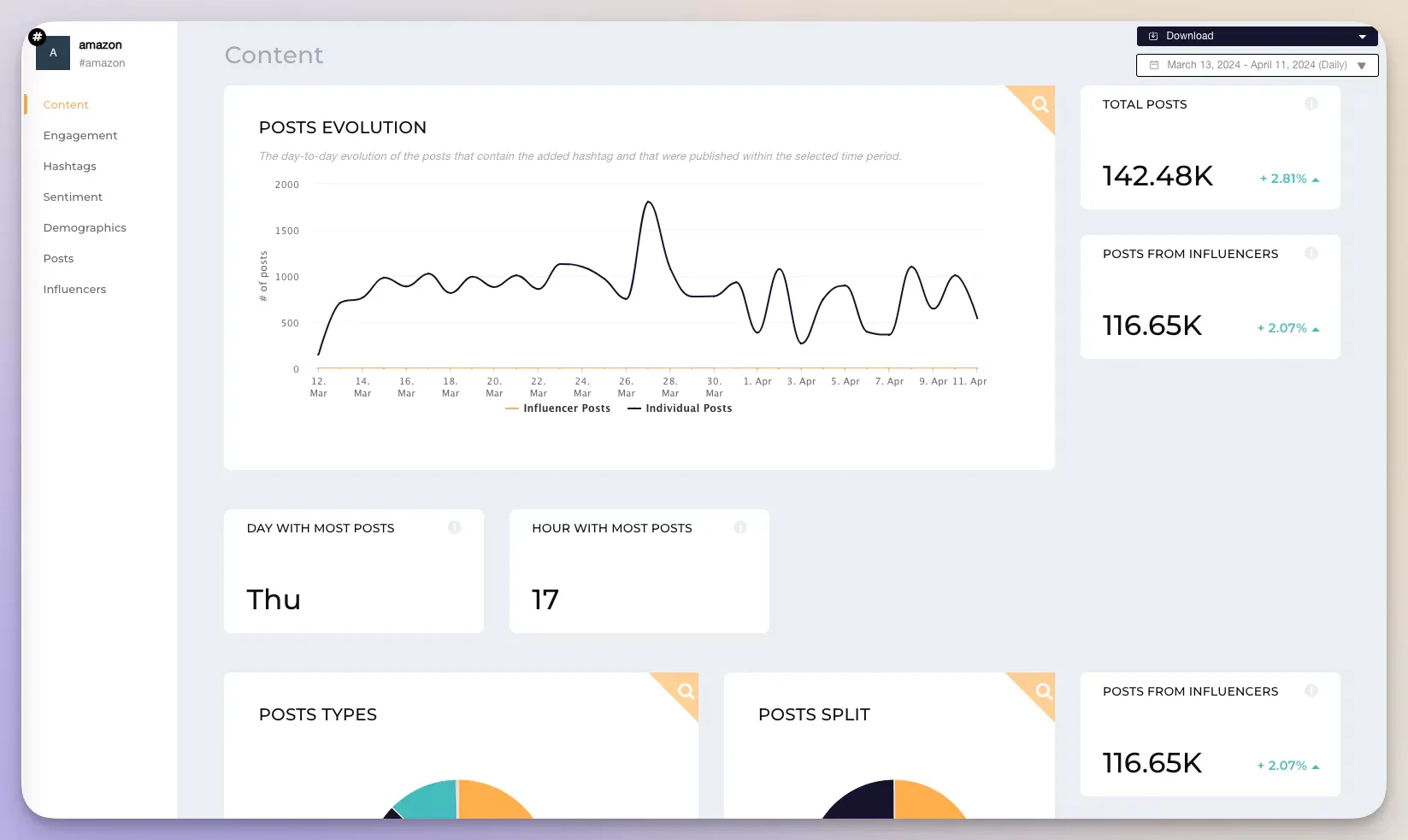
Take for example this Socialinsider’s insight on #amazon recent hashtag volume evolution and access to other valuable data like engagement, sentiment, demographics, and influencers.
7. 3 free social listening tools
I understand, adopting a new practice or adding a new tool to the budget list is not always an easy call.
But trust me, it is worth it.
This is why, I am giving you 5 options from which you can choose before taking the big leap and starting a subscription.
Let’s start:
1. Socialinsider - the best Instagram listening tool
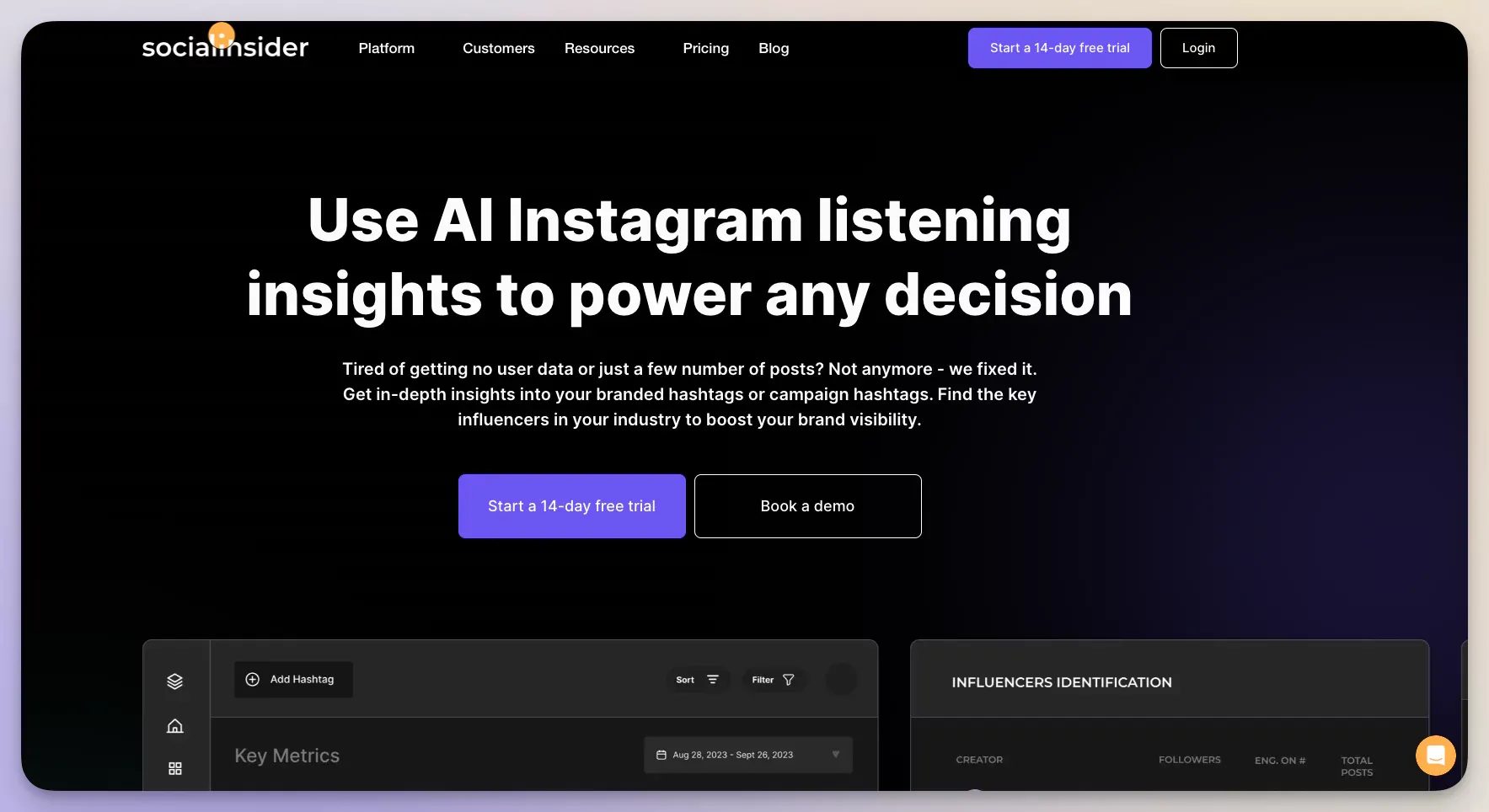
Pricing: free for the first 14 days, then starting at 50$ per month.
Socialinsider’s social listening features go beyond the traditional way of doing listening on Instagram. Built with AI at its core, it provides real-time insights into the following metrics:
- Hashtag posts
- Engagement metrics for a hashtag
- Popular hashtags used with your hashtag
- Sentiment & Emotion analysis
- Topic analysis
- Influencers interests
- Influencers analytics
- Brand collabs
- Hashtag benchmarks
Socialinsider is ideal for busy social media managers and marketing managers to use for content ideation, benchmarking, and reporting, and overall improve their social media strategy with competitive insights.
2. Gummy search - best for Reddit tracking
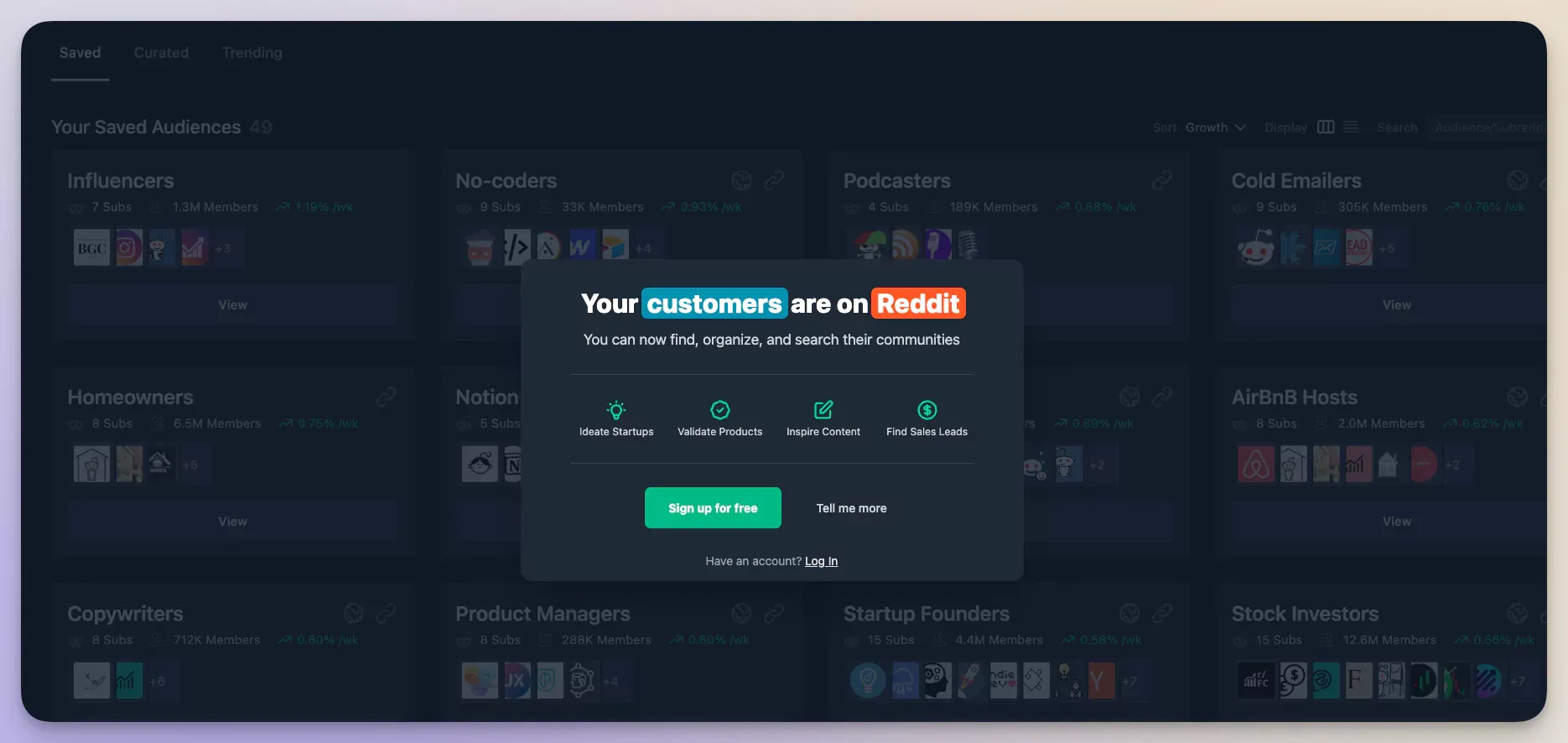
Pricing: free for anyone, but limited to 50 keyword searches.
The great thing about Gummy Search is the access to Reddit and subreddit topics, which is great for discovering communities and targeting your audience. This is great for content ideation, validating brand features, or creating brand awareness.
3. Google alerts - best for brand mentions
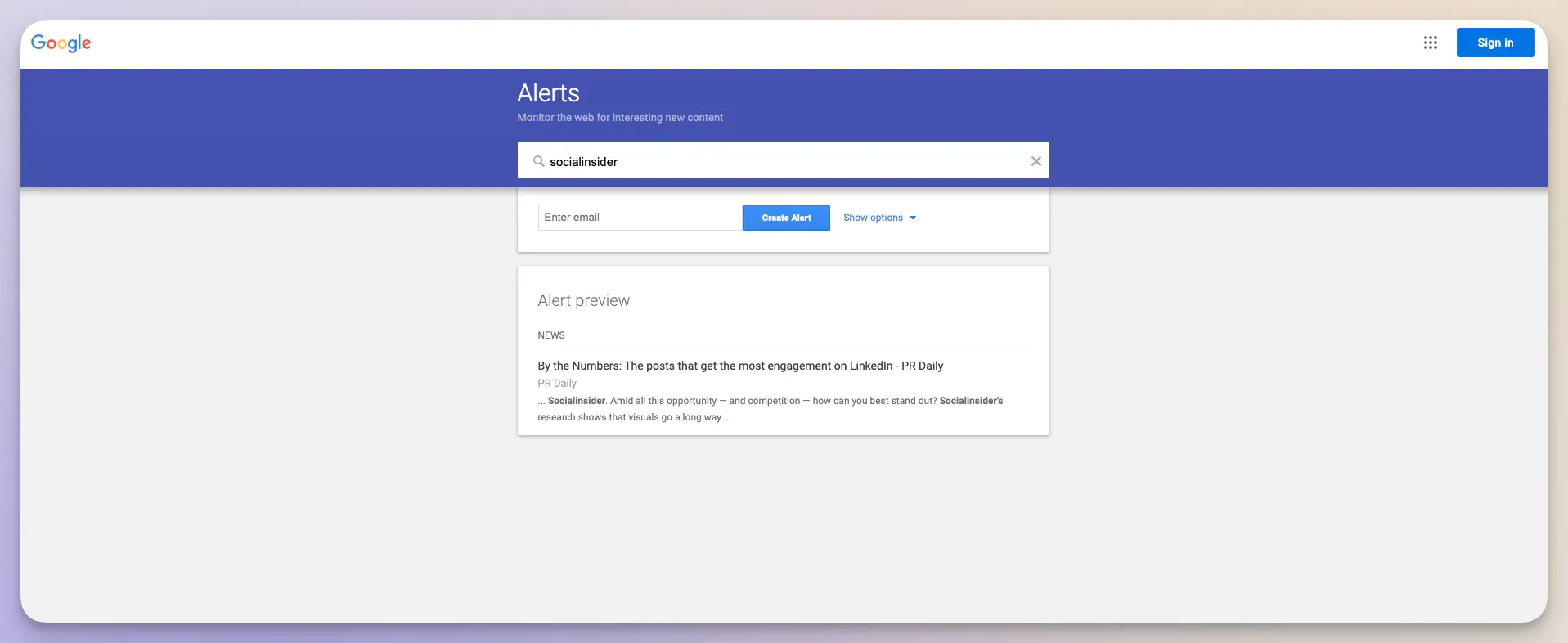
Google Alerts is a free service provided by Google that allows users to monitor the web for specific topics or keywords of interest.
Users can set up alerts for their chosen keywords and receive email notifications whenever Google indexes new content matching those keywords.
It's a simple and effective way to stay updated on relevant news, mentions, or discussions related to your interests, business, or industry.
Final thoughts
Although social listening is not a new concept, it is constantly evolving, together with social media platforms and their users.
With the integration of AI, on top of its capacities, social media listening is becoming an integral part of many businesses’ marketing strategies.
As marketers, it is important to keep up the pace and always search for new ways of engaging with our audience.
FAQs about social listening
How can social listening impact your social media strategy?
Social listening can greatly improve your social media strategy by adding a new layer of audience insights and product feedback, as well as providing a pool of highly engaged customers that could be turned into brand advocates.
What are the main limitations of social listening?
Social listening, for all its benefits, also has some limitations, such as the need for extensive filtering and cleanup (due to the massive amounts of raw data), occasional lack of context, etc.
What is the purpose of a social listening strategy?
A social listening strategy has the purpose of guiding you through all the steps needed to monitor your brand’s reputation on social media, gauge your audience’s sentiment towards your brand and find new brand advocates.
What is an example of brands doing social listening?
A good example of brands doing social listening would be Taco Bell. They are very active on social media and known for engaging with their customers in real-time and reaching out to them via social networks.







